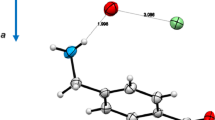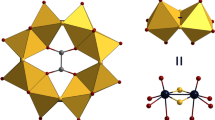Abstract
Derivatives of tris(4-fluorophenyl)antimony (4-FC6H4)3Sb(OC6H3F2-2,4)2 (1), (4-FC6H4)3Sb[OC(O)C6H3F2-2,5]2 (2) and (4-FC6H4)3Sb[OC(O)C≡CPh]2 (3) are prepared by oxidative addition reaction from triarylantimony (4-FC6H4)3Sb and 2,4-difluorophenol, 2,5-difluorobenzoic acid, and phenylpropiolic acid, respectively, in the presence of tert-butyl peroxide. According to the XRD data, the antimony atoms have a distorted trigonal-bipyramidal coordination with oxygen atoms of aryloxide and carboxylate ligands in axial positions. The OSbO axial angles are 174.7(2)° (1), 175.78(6)° (2), and 176.02(7)° (3). The Sb–C bonds in 1 are longer than Sb–O distances (2.073(4) Å) and are equal to 2.114(9) Å, 2.099(6) Å. The similar distances in 2 and 3 are 2.115(2)-2.124(2) Å and 2.1341(17) Å, 2.1222(18) Å; 2.079(2)-2.103(3) Å and 2.171(3) Å, 2.138(2) Å, respectively. The antimony atom deviates from the equatorial plane (C3) by 0.057 Å and 0.013 Å in 2 and 3, respectively, and lies in this plane in 1. Compounds 2 and 3 exhibit intramolecular interactions between the metal atom and the carbonyl oxygen atoms. The Sb⋯O=C distances are 2.845(2) Å, 2.969(2) Å (2) and 2.909(3) Å, 2.947(3) Å (3), which is much shorter than the sum of the van der Waals radii of Sb and O (3.58 Å). The spatial structure of crystals 1-3 is due to the presence of hydrogen bonds C=O⋯H, O⋯H, F⋯H, and CH⋯π-interactions. The structure of crystals 3 exhibits π–π interactions between the alkynyl group and the benzene ring of the carboxylate ligand of neighboring molecules.








Similar content being viewed by others
REFERENCES
R. Mushtaq, M. K. Rauf, M. Bond, A. Badshah, M. I. Ali, A. Nadhman, M. Yasinzai, and M. N. Tahir. Appl. Organomet. Chem., 2016, 30, 465. https://doi.org/10.1002/aoc.3456
L. Saleem, A. A. Altaf, A. Badshah, M. K. Rauf, A. Waseem, M. Danish, S. S. Azam, M. N. Arshad, A. M. Asiri, S. Ahmad, and R. Gul. Inorg. Chim. Acta, 2018, 474, 148. https://doi.org/10.1016/j.ica.2018.01.036
A. Islam, J. G. Da Silva, F. M. Berbet, S. M. Da Silva, B. L. Rodrigues, H. Beraldo, M. N. Melo, F. Frézard, and C. Demicheli. Molecules, 2014, 19, 6009. https://doi.org/10.3390/molecules19056009
R. Mushtaq, M. K. Rauf, M. Bolte, A. Nadhman, A. Badshah, M. N. Tahir, M. Yasinzai, and K. M. Khan. Appl. Organomet. Chem., 2017, 31, e3606. https://doi.org/10.1002/aoc.3606
T. Iftikhar, M. K. Rauf, S. Sarwar, A. Badshah., D. Waseem, M. N. Tahir, A. Khan, K. M. Khan, and G. M. Khan. J. Organomet. Chem., 2017, 851, 89. https://doi.org/10.1016/j.jorganchem.2017.09.002
A. Islam, B. L. Rodrigues, I. M. Marzano, E. C. Perreira-Maia, D. Dittz, M. T. P. Lopes, M. Ishfaq, F. Frézard, and C. Demicheli. Eur. J. Med. Chem., 2016, 109, 254. https://doi.org/10.1016/j.ejmech.2016.01.003
F. Wang, H. Yin, C. Yue, S. Cheng, and M. Hong. J. Organomet. Chem., 2013, 738, 35. https://doi.org/10.1016/j.jorganchem.2013.03.046
R. Kather, T. Svoboda, M. Wehrhahn, E. Rychagova, E. Lork, L. Dostál, S. Ketkov, and J. Beckmann. Chem. Commun., 2015, 51, 5932. https://doi.org/10.1039/C5CC00738K
S. K. Hadjikakou, I. I. Ozturk, C. N. Banti, N. Kourkoumelis, and N. Hadjiliadis. J. Inorg. Biochem., 2015, 153, 293. https://doi.org/10.1016/j.jinorgbio.2015.06.006
M. I. Ali, M. K. Rauf, A. Badshah, I. Kumar, C. M. Forsyth, P. C. Junk, L. Kedzierski, and P. C. Andrews. Dalton Trans., 2013, 42, 16733. https://doi.org/10.1039/c3dt51382c
J. Jiang, H. Yin, D. Wang, Z. Han, F. Wang, S. Cheng, and M. Hong. Dalton Trans., 2013, 42, 8563. https://doi.org/10.1039/c3dt50221j
L. Yu, Y.-Q. Ma, G.-C. Wang, and J.-S. Li. Heteroatom Chem., 2004, 15, 32. https://doi.org/10.1002/hc.10208
L. Yu, Y.-Q. Ma, R.-C. Liu, G.-C. Wang, J.-S. Li, G.-H. Du, and J.-J. Hu. Polyhedron, 2004, 23, 823. https://doi.org/10.1016/j.poly.2003.12.002
T. C. Thepe, S. J. Richard, R. J. Garascia, M. A. Selvoski, and A. N. Patel. Ohio J. Sci., 1977, 77, 134.
V. V. Sharutin, A. I. Poddelsky, and O. K. Sharutina. Russ. J. Coord. Chem., 2020, 46, 663. https://doi.org/10.1134/S1070328420100012
G. Ferguson, B. Kaitner, C. Glidewell, and S. Smith. J. Organomet. Chem., 1991, 419, 283. https://doi.org/10.1016/0022-328X(91)80241-B
V. V. Sharutin, O. K. Sharutina, and A. N. Efremov. Russ. J. Coord. Chem., 2017, 43, 565. https://doi.org/10.1134/S1070328417090081
V. V. Sharutin, O. K. Sharutina, and A. N. Efremov. Russ. J. Coord. Chem., 2016, 42, 737.
K. A. Kocheshkov, A. P. Skoldinov, and N. N. Zemlyansky. Metody elementoorganicheskoi khimii. Surma, vismut (Methods of the Organometallic Chemistry. Antimony, Bismuth). Moscow: Nauka, 1976.
Bruker. SMART and SAINT-Plus. Versions 5.0. Data Collection and Processing Software for the SMART System. Madison, Wisconsin, USA: Bruker AXS Inc., 1998.
Bruker. SHELXTL/PC. Versions 5.10. An Integrated System for Solving, Refining and Displaying Crystal Structures from Diffraction Data. Madison, Wisconsin, USA: Bruker AXS Inc., 1998.
O. V. Dolomanov, L. J. Bourhis, R. J. Gildea, J. A. K. Howard, and H. Puschmann. J. Appl. Crystallogr., 2009, 42, 339. https://doi.org/10.1107/S0021889808042726
A. V. Vasilev, E. V. Grinenko, A. O. Schukin, and T. G. Fedulina. Infrakrasnaya spektroskopiya organicheskikh i prirodnykh soedinenii (Infrared spectroscopy of organic and natural compounds). SPb: SPbFTU, 2007. [In Russian]
B. N. Tarasevich. IK spektry osnovnykh klassov organicheskikh soedinenii (IR Spectra of the Main Classes of Organic Compounds). Moscow: MGU, 2012.
Spectral Database for Organic Compounds (SDBS). Release 2021. Japan: National Institute of Advanced Industrial Science and Technology, 2021.
Cambridge Crystallographic Database. Release 2020. Cambridge, UK: University of Cambridge, 2020.
V. V. Sharutin, O. K. Sharutina, A. N. Efremov, and P. A. Slepukhin. Russ. J. Inorg. Chem., 2020, 65, 992. https://doi.org/10.1134/S0036023620010155
V. V. Sharutin and O. K. Sharutina. Russ. Chem. Bull., 2017, 66, 707. https://doi.org/10.1007/s11172-017-1796-6
S. S. Batsanov. Russ. J. Inorg. Chem., 1991, 36, 1694.
Funding
The reported study was funded by RFBR, project number 20-33-90099.
Author information
Authors and Affiliations
Corresponding author
Ethics declarations
The authors declare that they have no conflicts of interests.
Additional information
Russian Text © The Author(s), 2022, published in Zhurnal Strukturnoi Khimii, 2022, Vol. 63, No. 3, pp. 261-270.https://doi.org/10.26902/JSC_id88696
Rights and permissions
About this article
Cite this article
Efremov, A.N., Sharutin, V.V. & Sharutina, O.K. SYNTHESIS AND STRUCTURE OF TRIS(4-FLUOROPHENYL)ANTIMONY (4-FC6H4)3SbX2 DERIVATIVES (X = OC6H3F2-2,4, OC(O)C6H3F2-2,5, OC(O)C≡CPh). J Struct Chem 63, 344–352 (2022). https://doi.org/10.1134/S0022476622030039
Received:
Revised:
Accepted:
Published:
Issue Date:
DOI: https://doi.org/10.1134/S0022476622030039




